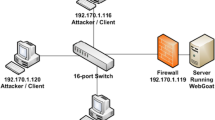Abstract
Over the last years Voice-over-IP (VoIP) is getting widespread a dop tion from business and residential customers.The preference towards VoIP ser vices stems from the fact that VoIP provides many ways to com mu ni ca te, with a lower cost than traditional telephony. However, VoIP in its present form may allow malicious users to exploit a number of vulnerabilities, make bulk un so li cited telephony calls and send bulk unsolicited instant messages. This ex p loi ta tion is referred to as Spam over Internet Telephony (SPIT). In this pa per we int roduce an antiSPIT management architecture, by using on to logies, which allow domain administrators to detect and handle SPIT auto ma tically, ba s ed on pre de fined requirements and preferences.
Preview
Unable to display preview. Download preview PDF.
Similar content being viewed by others
References
VOIPSA, VoIP Security and Privacy Threat Taxonomy (October 2005), http://www.voipsa.org/Activities/taxonomy.php
Rosenberg, J., Jennings, C.: The Session Initiation Protocol (SIP) and Spam, draft-ietf-sipping-SPAM-03 (October 2006)
Dritsas, S., Mallios, J., Theoharidou, M., Marias, G., Gritzalis, D.: Threat analysis of the Session Initiation Protocol regarding spam. In: Proc. of the 3rdIEEE International Workshop on Information Assurance (WIA 2007), April 2007, pp. 426–433. IEEE Press, USA (2007)
Marias, G., Dritsas, S., Theoharidou, M., Mallios, J., Gritzalis, D.: SIP vulnerabilities and anti-SPIT mechanisms assessment. In: Proc. of the 16th IEEE International Conference on Computer Communications and Networks (ICCCN 2007), August 2007, pp. 597–604. IEEE Press, Los Alamitos (2007)
Gritzalis, D., Mallios, Y.: A SIP-based SPIT management framework. Computers & Security 27(5-6), 136–153 (2008)
Rosenberg, J., et al.: SIP: Session Initiation Protocol, RFC 3261 (June 2002)
Johnston, A.: SIP: Understanding the Session Initiation Protocol. Artech House (2004)
Sloman, M., Lupu, E.: Security and management policy specification. IEEE Network, Special Issue on Policy-Based Networking 16(2), 10–19 (2002)
Dritsas, S., Soupionis, J., Theoharidou, M., Mallios, J., Gritzalis, D.: SPIT Identification Criteria Implementations: Effectiveness and Lessons Learned. In: Samarati, P., et al. (eds.) Proc. of the 23rd International Information Security Conference (SEC 2008), September 2008, pp. 381–395. Springer, Milan (2008)
Mallios, J., Dritsas, S., Tsoumas, B., Gritzalis, D.: Attack modeling of SIP-oriented SPIT. In: Lopez, J., Hämmerli, B.M. (eds.) CRITIS 2007. LNCS, vol. 5141. Springer, Heidelberg (2008)
Gruber, T.: Toward principles for the design of ontologies used for knowledge sharing. In: Formal Ontology in Conceptual Analysis and Knowledge Representation, March 1993. Kluwer Academic Publishers, Dordrecht (1993)
Guarino, N.: Understanding, Building, and Using Ontologies: A commentary to “Using explicit ontologies in KBS development. International Journal of Human and Computer Studies 46(3/4), 293–310 (1997)
Dritsas, S., Dritsou, V., Tsoumas, B., Constantopoulos, P., Gritzalis, D.: OntoSPIT: SPIT management through ontologies. Computer Communications (April 2008) (in press)
Dritsas, S., Mallios, J., Theoharidou, M., Marias, G., Gritzalis, D.: Threat analysis of the Session Initiation Protocol, regarding spam. In: Proc. of the 3rd IEEE International Workshop on Information Assurance, April 2007, pp. 426–433. IEEE Press, New Orleans (2007)
W3C Recommendation, The Ontology Web Language
OWL. W3C Recommendation. The Ontology Web Language (2004)
W3C. W3C Recommendation (10-02-2004), OWL Guide (2004)
Horrocks, I., Patel-Schneider, P., Boley, H., Tabet, S., Grosof, B., Dean, M.: SWRL: A Semantic Web Rule Language Combining OWL and RuleML, The DARPA Agent Markup Language Homepage
SIP Express Router (SER), Iptel.org.
Example SER deployments, http://mit.edu/sip/sip.edu/deployments.shtml
Protégé, Ontology development environment (2005), http://protege.stanford.edu/
Author information
Authors and Affiliations
Editor information
Editors and Affiliations
Rights and permissions
Copyright information
© 2010 ICST Institute for Computer Science, Social Informatics and Telecommunications Engineering
About this paper
Cite this paper
Dritsas, S., Gritzalis, D. (2010). An Ontology-Driven antiSPIT Architecture. In: Sideridis, A.B., Patrikakis, C.Z. (eds) Next Generation Society. Technological and Legal Issues. e-Democracy 2009. Lecture Notes of the Institute for Computer Sciences, Social Informatics and Telecommunications Engineering, vol 26. Springer, Berlin, Heidelberg. https://doi.org/10.1007/978-3-642-11631-5_18
Download citation
DOI: https://doi.org/10.1007/978-3-642-11631-5_18
Publisher Name: Springer, Berlin, Heidelberg
Print ISBN: 978-3-642-11629-2
Online ISBN: 978-3-642-11631-5
eBook Packages: Computer ScienceComputer Science (R0)




